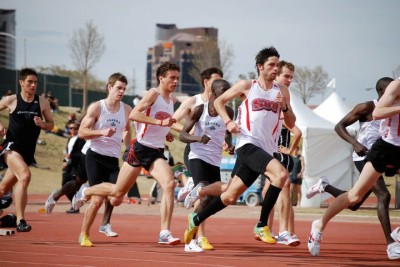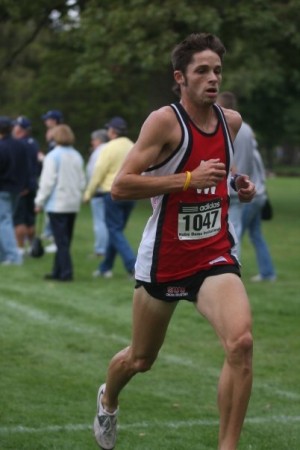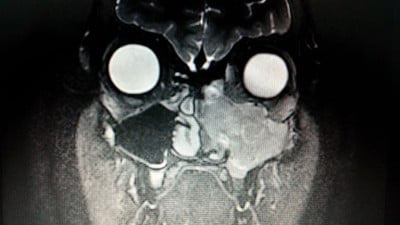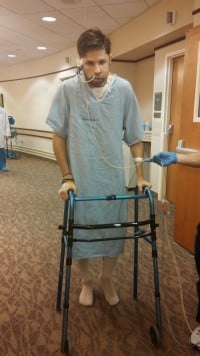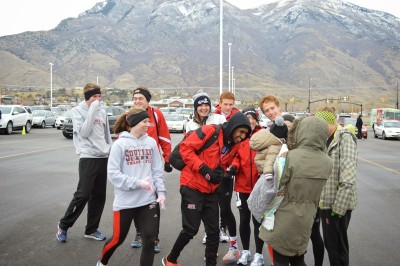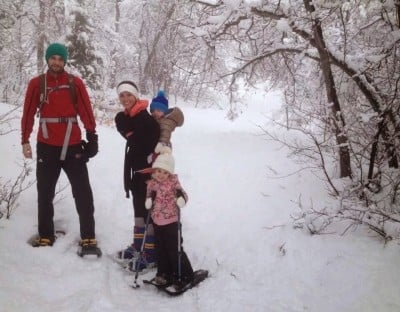The Nate Houle Story: “Trying to live life while you’ve still got it.”
By Jonathan Gault
March 6, 2015
Photos courtesy of the Houle family
On the morning in October 2014 that she found out her husband had cancer, Kacee Houle went for a run. Though it would be another hour until doctors officially diagnosed her husband, Nate, with squamous-cell carcinoma — a type of cancer usually reserved for those in their 70s, not 29-year-old former collegiate athletes — Kacee knew. Kacee had already dressed for her run, shorts and a long-sleeve T-shirt, when the phone rang. She waited until her husband hung up to head out the door.
“That was the doctor’s office,” Nate said. “They want us to come in this morning. Like in an hour.”
Kacee’s heart sank to her feet.
“Well that’s probably not good,” she said. “Do you care if I go get just a quick run in? I need it, especially now.”
“Course. Have fun.”
As Kacee stepped out the door of their Lindon, Utah, home and into the crisp fall air, she tried her best to remain calm. But in the back of her mind, she had a feeling that her husband had cancer. Nate had had surgery four days earlier to remove what doctors believed to be a benign tumor inside his sinus on the left side of his face. They had assured the Houles the possibility of cancer was extremely slim — around two percent. Yet as she ran along the paved Murdock Canal Trail, she began to think about the possibilities and started to pray. She followed the path through the farmland as it weaved behind her neighbors’ back yards and thought that she and Nate would get through his cancer the same way they had gotten through so many workouts as collegiate runners — one rep at a time. She decided this would be a good approach if Nate did indeed have cancer.
Normally this would have been a perfect morning for a run. The sun was starting to shine, and one tree Kacee passed had such vibrant fall foliage that it appeared to be on fire. She couldn’t appreciate any of it — not when her husband was about to face the fight of his life — but in retrospect, Kacee is glad she got out the door that morning.
“I think that run actually helped a ton because it gave me time to realize that it probably was cancer,” Kacee said. “Even though we were about to start something that no one should have to start, that it was okay and that we could get through it.”
An hour later, in the doctor’s office, Kacee’s worst fears were confirmed: Nate had cancer, specifically squamous-cell carcinoma localized to his face.
The last year had been trying on the Houles. Kacee had suffered postpartum depression and anxiety after giving birth to their son, Ames, in October 2013. Then, in June 2014, Nate lost his dream job coaching the middle distance runners at Southern Utah University, his alma mater, for reasons 100% out of his control explained later in this story.
In August, Nate took a position at a software company in Salt Lake City, forcing him and Kacee to move to Lindon, three hours north of Cedar City (where SUU is located). Nate, a devout Mormon, struggled to understand God’s plan for him. For months, he’d ask himself how the clear, straight path he had been on had become so foggy and tangled. He never had an answer.
And then, on that October morning in the doctor’s office, a light bulb clicked in his head. Cancer is a disease that produces a thousand questions, and Nate and Kacee asked plenty in the office that day. But this time, it also provided Nate with an answer. Why would God take Nate away from SUU, away from a job he loved and a school that embraced him? Nate had finally figured it out.
***
Nate Houle was born to coach runners, even if he didn’t see it that way for the first 20 years of his life. He started running when he was seven, and by the next year, he was running in his first USATF Junior Olympics national championship. His father, Kirk, coached him, and continued to do so throughout Nate’s successful career at track powerhouse Mountain View High School in Orem, Utah. Nate won state championships at 800 meters in 2002 and 2003 and his times were fast enough to attract the interest of his uncle, Eric, the head coach at Southern Utah.
When Nate visited SUU in 2002, one of the athletes on the team at the time, Rob Oslund, could tell right away that the Thunderbirds could use Nate.
“The kid was a speedster,” Oslund said. “He had that 800 speed. That’s the first thing I remember about him. Not really meeting him with the handshake, not the ‘Hey, how you doing?’ I remember him doing a workout on that track when he came up as a high schooler. He had a lot of speed, quick turnover.”
With his older sister Heather already on the team (younger sisters Heidi and Ashley would later join them), SUU was a natural choice. Nate enrolled in the fall of 2003.
Kirk and Eric were hardly alone in their coaching exploits. There were six Houle brothers in all (plus five sisters), and all of the men coached track: Mark, the oldest, just retired as coach of Menahga (MN) High School; Dave, a member of the National High School Hall of Fame, amassed 68 state championships coaching with Kirk at Mountain View; John, who passed away last year, coached at Orem High; the youngest brother, Scott, is the head man at Utah Valley University.
While most outsiders would assume that Nate would be the next Houle to take up coaching, Nate decided he wanted to try to carve out his own road. Rather than follow in the family business, he started off with the goal of majoring in engineering before switching to pre-dental. Yet as his career at SUU wore on, Nate became engrossed with the sport of running, particularly his favored middle distance events. He scoured the Internet (occasionally visiting the forums of a certain running website) for knowledge and searched for coaching presentations where he could learn about the middle distance events from the sport’s brightest minds.
In particular, Nate looked for coaches whose athletes consistently performed better than he thought they would. He was impressed when Texas’ Leo Manzano won the NCAA title in the 1500 as a freshman in 2005 under Jason Vigilante (now at Princeton). In the coming years, as Manzano and Jacob Hernandez won national championships and the Texas distance medley relay team set an indoor world record, Nate’s interest in Vigilante only intensified and he sought to learn everything he could about his methods.
As a runner, Nate was injury-prone and those injuries saw him drop down to become a 400/800 runner rather than the 800/1600 runner he had been in high school. There was a positive side effect to being hurt, however. Nate’s injuries forced Eric to modify his traditional training plan and that allowed the two to work together more closely as they planned out Nate’s regimen. Though Nate wasn’t always healthy, he contributed when he was on the track: he was part of SUU’s 4×400 relay squad that qualified for the NCAA Regional meet in 2009 and ran 3:11.95, just 14 hundredths of a second off the school record.
“He knew statistics around the country, the world,” Eric Houle said. “He basically just lived track and field.”
When he wasn’t talking training with his coach, Nate would stay up deep into the night with teammates Nigel Sharp and Cam Levins, discussing their goals for the team and race strategy. Levins, whom Nate hosted on his recruiting trip (the two shared an off-campus house with several teammates during Levins’ sophomore year), has counted Nate among his friends ever since.
“Even after he graduated, I’ve always looked to Nate when I’ve had any thoughts or questions about my training,” said Levins, a two-time NCAA champ at SUU who represented Canada in the 2012 Olympics and claimed the bronze medal in the 10,000 at last summer’s Commonwealth Games. “Even now, I’ll ask him things. Before he became a coach himself, he was always like that.”
By the time he graduated in 2010 with a degree in exercise science (he served a mission in Portugal from 2004 to 2006), Nate knew he wanted to be a coach.
***
After living his entire life in Utah, Nate was ready for an adventure. He had met Kacee during the summer of 2009 while they worked in a local running store (she was a runner for the University of Utah) and they married shortly after he graduated from SUU. Now they had to decide where they would spend the next two years for Nate’s graduate school. Nate applied to about 10 schools to pursue his masters degree in physiology, getting into about half of them. One of the last schools on his list was Georgia State University in Atlanta, but it quickly became apparent that he was destined to go there. The director of the muscle biology lab offered Nate a graduate research position that would pay for his schooling and cross country coach Chris England agreed to take him on as a volunteer assistant. England even said he could find some scholarship money for Kacee if she transferred from Utah.
“It was kind of a no-brainer,” Nate said.
England had so much confidence in Nate that by his second year, Nate — still a volunteer assistant — was in charge of the entire men’s and women’s mid-distance squad. By the time he graduated from Georgia State in 2012 (conveniently, the same year when Kacee’s eligibility expired), Nate had enough experience for his uncle to come calling. That fall, Nate and Kacee were back in Cedar City with Nate serving as a part-time assistant under Eric.
Nate loved being a part of the SUU community again and with Levins having just won a pair of titles at the 2012 NCAA outdoor championships, track was becoming a popular sport in Cedar City. One of the SUU athletes, Hayden Hawks, had the idea to perform community service by starting up a youth track club and he reached out to Nate to help get it off the ground. The next year, Hawks had an internship so Nate and Kacee took over the program. Within two years, the Cedar City Track Attack had 80 kids covering every event group.
“The guy’s a coach,” Oslund said. “He lives and breathes coaching and running and just has a passion for it. It’s inspiring to see that.”
***
Until the summer of 2014, Nate’s life had gone pretty much according to script. Sure, he’d had some injuries in college, but he had a beautiful wife, a young son, Ames (born October 2013) and, after some departures opened up a spot, a full-time assistant’s job at his alma mater. The road ahead seemed straight and clear: keep climbing up the coaching ladder, with a head gig lying somewhere in the future.
The first pothole in that road came prior to the 2014-15 school year when SUU interim president Richard Kendell gave way to replacement Scott Wyatt.
Under Kendell, Nate had come under scrutiny when he was hired on full-time due to the school’s nepotism policy, which states that “it is unlawful for a public employee to appoint, employ, or vote for or recommend the appointment of a relative in or to any position or employment when the salary, wages, pay or compensation of the appointee will be paid from public funds and the appointee will be directly supervised by a relative.” The school went through a lengthy independent hiring process — in which Nate’s uncle, Eric, had no involvement — before ultimately keeping Nate on full-time. Nate thought that was the last he’d hear about the nepotism policy, but it resurfaced once Wyatt took over.
“For some reason (Wyatt) was notified that there was, this was a gigantic issue again,” Nate said. “I don’t know why that was on the forefront of his mind as brand-new university president, to deal with an assistant track coach so intently. But he was pretty intent about it, went on a crusade a little bit…I got singled out for some reason, they made sure that it happened and I was removed.
“It was really strange, no one really understood what was going on. I’m a religious guy, I’m a big believer that a lot of times things happen for a reason. And I was really confused. Coaching was what I was meant to do, my education was all for this, my passion was all for this…All of a sudden this giant door closed and I was like, ‘What on Earth just happened?'”
Wyatt refused to comment for this story. SUU athletic director Ken Beazer explained Nate’s dismissal as follows:
“There were three administration changes within a year’s period of time. The former president (Michael Benson), an interim administration (Kendell) and a new administration (Wyatt). It was just a change, there was a change in the way the different administrations looked at the nepotism policy. [Nate] was on a temporary contract and hoping to get solidified further with the new administration and that just didn’t happen.”
“I felt heartsick that I had to lose him from here coaching because in my opinion he will be one of the best coaches the sport could have given enough time and opportunity,” Eric Houle said. “He’s very dedicated, very knowledgeable and inspiring.”
His job ripped away from him, his world turned upside down, Nate didn’t know what to do. He spent two months looking for jobs both in and out of coaching and finally secured a position with Tomax, a software company in Salt Lake City. Kacee’s grandparents had moved out of their home in nearby Lindon and were trying to sell it; Nate, Kacee and Ames moved in there temporarily to ready it for sale.
Nate started riding the train into the city for work, something he didn’t enjoy. And though he had no problems with his company, he knew deep down working in the software industry wasn’t for him. His future was uncertain and his present was unsatisfying. Nate Houle was lost.
***
Nate had felt sick ever since moving to Lindon in the early fall. He had a bad cold, and, determining that it was a sinus infection, went on antibiotics. He started to feel better but his sinus was still bothering him enough for him to visit the doctor, who recommended another round of antibiotics and instructed Nate to come back in two weeks if things didn’t improve.
Instead of improving, Nate’s condition worsened. His left cheek had started to go numb, his left eye began to bug out of its socket; in fact, most of the left side of his face had become swollen. Nate returned to the doctor’s office, underwent a CT scan and later an MRI, which revealed a large tumor in his sinus. The tumor had protruded through three of his bones into his eye socket and septum; though the doctor believed his tumor to be benign, he scheduled Nate for surgery within the week to have it removed.
Nate had the surgery on October 17, and it went well. The doctor believed Nate’s tumor was an inverted sinonasal papilloma, which would require a few follow-up surgeries but was non-cancerous.
Then Monday morning rolled around. The doctor’s office called, asking for Nate to come in immediately. Kacee went for her run, preparing herself for the worst. The Houles went into the office, where Nate’s doctor, Kirt Beus, delivered the news no one wanted to hear:
“I got the lab results in late Friday afternoon. They did come back cancerous…”
Kacee began to cry. Nate approached things differently.
“If you were to ask me before, (my reaction to being diagnosed with cancer is) totally different than I thought (it would be),” Nate said, months later. “Cancer sounds like a death sentence to me a little bit, but the way I’ve thought about it was as soon as I found out, I was like, ‘Whatever, I don’t care.’ It took a little to settle in, but I’ve never felt this fear of death. I’m very calm, very confident that I’m not gonna die from this. I am not too stressed about it honestly. I just figure it’s like any sickness. It’s just a matter of time before you get on with it, this one just sucks extra bad.”
The diagnosis of squamous-cell carcinoma — a type of cancer rarely seen in the sinus, especially for a non-smoker in his 20s — gave Nate a lot of time to think. And the more he thought, the more he realized that the seemingly arbitrary twists and turns his life had taken — losing his coaching job, moving to Lindon — were all part of God’s plan for him. If Nate had been back in Cedar City, he would have been on the road recruiting and traveling to meets every week; he would have put off going to the doctor’s to check out his sinus. If he had been back in Cedar City, he wouldn’t have had access to the University of Utah’s Huntsman Cancer Institute in Salt Lake City for his treatment. His road would only get tougher; Nate knew that. But he took solace in the fact that he was on the road, and that he had been all along.
Running had always been a huge part of both Nate and Kacee’s lives, and Kacee began to draw on her experiences in the sport to help her navigate Nate’s battle.
“I know that the previous trials we had to go through this year were all just practice,” Kacee wrote on her blog three days after the diagnosis (in addition to Nate losing his job, Kacee had also battled post-partum depression and anxiety). “They were just really, extremely hard repeats. One of those workouts that you really didn’t think you would get through, but somehow you were laying on your back afterwards amazed that you did. Those workouts made us strong, both physically and mentally, and now we are lined up for the race. It super sucks that our race is cancer. But I 100% do know that we were given this trial for a reason. It’s going to be hard – every race is. But after going through tons of races I know that if you race relaxed, confident, and have lots of fans cheering you on the race is always easier, more enjoyable, and the outcome is way better.”
***
Nate underwent majory surgery on November 13 to remove the cancer from the left side of his face. It would prove to be the longest day of Kacee’s life. The Houles left their house at 5 in the morning and by 7:30, Nate had been wheeled into the operating room. As the surgeons worked — first removing much of his cheek and upper jaw, the roof of his mouth and all of his molars and then reconstructing his face with tissue and bone from his left fibula — Kacee spent the rest of the day at a nearby hotel room. She wondered what her husband would look like when she saw him again — there was a 90 percent chance that they would have to remove his left eye as part of the surgery too, and that was the only thing about this whole ordeal that rattled Nate. He hated the idea of living the rest of his life with only one eye. Nate’s parents brought the toddler Ames to stay with her and one of her high school teammates stopped by to hang out. Those distractions worked, to a point, but all Kacee cared about on that day was the call she received every two hours from the nurse in the operating room, who would update her on Nate’s status.
Around 9 or 10 that night, Kacee returned to the hospital. A little after midnight, over sixteen hours after he entered surgery, Nate was wheeled into the intensive care unit. Nate still felt out of it when he woke up, but as he looked out at the world — with both eyes — a wave of terror washed over him. Why hadn’t the surgeon removed his left eye? What had gone wrong? Was he going to die?
Nothing had gone wrong. In fact, the surgery couldn’t have gone any better. The doctors had been prepared to take the eye if they thought it posed the slightest risk, but they had found no reason to do so. Kacee, relieved at the news, rushed in to see her husband. But the figure propped up in the bed bore little resemblance to the man she had married in the white tuxedo four years earlier. Three pieces of medical tape connected an IV and gauze to his right arm; a tangle of wires engulfed the other. A long, clear tube branched off at the top of his chest, one end finding its way into his nose, the other into his trachea through a hole in his neck. His blue medical gown was crumpled, his entire face swollen.
Kacee reached in to give Nate a kiss, to tell him she loved him, and she began to feel dizzy, her ears ringing. Almost fainting, she collapsed on the couch nearby and fell asleep almost immediately.
***
The first week of Nate’s recovery, all spent in the hospital, was grueling. He couldn’t walk without a walker, ate through a feeding tube and had to learn to breathe through the hole in his neck while coughing up drainage that piled up as a result of his surgery. It felt like he was drowning. Kacee slept in his hospital room every night that week; both she and Nate were mentally and emotionally spent.
Worse still, was a phone call Kacee received in the hospital just days after Nate’s surgery. It was her aunt, who told her that she and Nate had to be out of her grandmother’s house in 10 days. Out, as in, for good.
“They were only thinking about their situation and not thinking about ours,” Kacee said. “I couldn’t believe they were doing that to us. I was just so hurt, so angry.”
Kacee tried negotiating and spoke with another one of her aunts. Kacee’s father asked the family to back off, at least until Nate and Kacee could find their feet again. Even with Nate out of commission, though, the message to Kacee was clear — her aunt wanted them out of the house. Her parents came to the rescue. They had been looking for a second home in Utah anyway, after moving to Texas — and bought a house in Cedar Hills. About a week and a half after that initial 10-day window, Kacee, Nate and Ames were out of her grandparents’ house and back in Cedar Hills.
The housing situation was difficult for the Houles, but it was overshadowed by the tremendous support they received from the SUU community. The first, and most poignant, event was a road race held just two days after Nate’s surgery in November. Nate’s sister, Heidi, felt that a running event would be the best way to honor him. She decided to name it the DomiNATE 5k, after a nickname Nate gained from dominating Kacee’s family football pick ’em pool. Kacee started using #teamdomiNATE in her blog and started a fundraiser page online with the same name.
Initially, Heidi anticipated about 100 runners, with the proceeds helping to pay the Houles’ medical bills and living expenses while Nate underwent treatment. The running community in Utah is tight-knit, however, and as word spread, the entries rose and rose, with over 700 runners showing up on the day. Many not only ran, but donated items — including a treadmill — for a silent auction or giveaways after the race.
The SUU cross country teams even showed up, despite the fact that they had raced at the NCAA Mountain Regional meet in Albuquerque the day before. The regional races wrapped up just after 1:30 p.m., giving the teams less than 23 hours to cool down, fly from Albuquerque to Las Vegas, make the two-and-a-half-hour drive from Vegas to Cedar City and grab a few hours of sleep before making the three-plus-hour drive from Cedar City to Highland, where the race was being held. But come 11 a.m. on Saturday, almost all of the members of the SUU cross country teams were on the start line, running for their former coach.
“I was kind of nervous for [the race] at first,” Kacee said. “I knew we had a lot of people sign up and I was nervous to have to talk to people. But once I got there, I was so overwhelmed by the love from everybody. Everyone was giving hugs. It was a boost for my morale. I knew the running world was already a good group of people, but it made me realize there are so many good people in this world. That race was the biggest blessing in this really stressful time.”
The support didn’t end there. The Houles received anonymous gift baskets at their house containing food and cash donations. Beazer, the SUU AD, donated $1 to the Team DomiNATE fund for every ticket sold at several SUU sporting events, including a home football game. The Utah Business Insurance Company bought them Christmas presents — a motorized car for Ames, a set of tools and snow boots for Nate, and a 50″ TV for Kacee. In all, Team DomiNATE has raised over $45,000 for the Houles.
“We just have been super blessed for everything,” Kacee said. “Shoutout to everybody who has helped us. It’s been a awesome how great everyone has been; we’re just super grateful for everything.”
***
Nate gradually improved in the weeks after his surgery; by New Year’s, Kacee felt as if she had her husband back. But cancer is a bitch. Nate started radiation therapy on January 5, and that has made life more difficult. Every weekday for the next seven weeks, he made the 45-minute drive to the Huntsman Center so that his face could be blasted by 20 minutes of radiation, an attempt to kill every last cancer cell in his face. Eating, in particular, has become a chore. His jaw is so full of scar tissue that it can barely open; everything he eats must be blended up. Nate’s mouth is full of painful sores and his sense of taste has gradually disappeared; it’s now at the point where everything tastes like metal. The effects of radiation have started to make the left side of his face appear sunburned and hairless. His left eye doesn’t drain properly anymore; if feels as if it’s glued shut every morning. Nate can jog around a little — it took him a while just to walk after his initial surgery, but nothing longer than half a mile.
During his radiation treatment, most days Nate would rise around 10 a.m. and drive to Salt Lake City for his treatment. Upon his return home, he would take a nap and play with Ames or read to him. Nate takes pleasure in watching his son grow and learn about the world around him.
“He’s starting to figure a lot of stuff out,” Nate said.
In the past, Nate endured winter rather than enjoying it, but his diagnosis has changed his outlook on life. He and Kacee try to head outdoors most days; recently, they’ve enjoyed snowshoeing.
“Trying to live life while you’ve still got it,” Nate said.
Nate has heard so much from doctors about his cancer that he’s forgotten half of it. Now that the radiation is done, his doctors have proclaimed him cancer-free — a huge step in the right direction. But there will be several follow-up surgeries, some aimed at working on that scar tissue in his mouth so that he can fully open his jaw again, and there will be check-ups every few months. And there’s still a 40 percent chance that his cancer returns. If that happens, it becomes much harder to treat.
“That’s when things get scary,” Kacee said.
But Nate sees no point in worrying about the what-ifs down the road. He has a life to live.
“My plan is once radiation’s done is just going back to life,” Nate said. “I’m pretty sick of this.”
Nate was forced to quit his job at Tomax after his cancer diagnosis, but he said they’ve been “insanely supportive” and that, should he return from his therapy in a reasonable amount of time, there’s an understanding that he can return to his old position.
But Nate’s passion remains coaching. He operates an online coaching service called Forca Running and is coaching Kacee and Heidi to run the Boston Marathon in April.
“[Running] has helped a ton,” Kacee said. “Really the only time I haven’t run since the diagnosis — it’s been over three months — and the only time was during his surgery and a week or so after.”
Right now, coaching is a diversion for Nate, something to get his mind off the disease that his body is battling. He cannot wait until their roles are reversed, for the time that cancer is relegated to the backburner as coaching once again occupies his life.
There is no finish line in sight for Nate, no bell ringing with a lap to go; the disease could return at any moment. And that’s why he has decided not to think about the future and what will happen to him down the road. Of all the people in his life, he’s dealt with his diagnosis the best; many of his friends and family have spent time playing the “what-if” game, worrying about what could happen should the worst-case scenario play out. Even Kacee still struggles with it. She loves Nate so much and there are so many unknowns that she cannot help but fear what might happen.
Nate doesn’t see the point to that approach. Worrying about what could happen will not make him better; if anything, it will upset his loved ones even more. So he does not worry. He takes cancer one day at a time. In the world of sportswriting, that’s a cliche, a phrase a coach throws at you when he doesn’t want to answer a question. But if you think about it, it’s not a bad way to deal with cancer. Taking life one day at a time allows Nate to appreciate every trip outdoors with Kacee, every moment he spends with Ames at home. It allows him to appreciate every act of kindness, every message of support.
Coaching always appealed to Nate because he is fascinated by the human body, how it changes and adapts to new stimuli. For most of Nate’s life, those stimuli were workouts — long runs, intervals on the track. Right now, it’s cancer. But he knows that in each case, the goal is the same: to emerge stronger.
For more on the Houles, be sure to check out Kacee’s blog. Nate’s coaching services are offered at Forca Running.
Nate is the LRC runner of the month. Got someone who you think is deserving? Email us at letsrun@letsrun.com.

